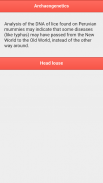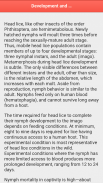










Head Louse

Beschreibung von Head Louse
The head louse (Pediculus humanus capitis) is an obligate ectoparasite of humans that causes head lice infestation (pediculosis capitis). Head lice are wingless insects spending their entire lives on the human scalp and feeding exclusively on human blood. Humans are the only known hosts of this specific parasite, while chimpanzees host a closely related species, Pediculus schaeffi. Other species of lice infest most orders of mammals and all orders of birds, as well as other parts of the human body. Lice differ from other hematophagic ectoparasites such as fleas in spending their entire lifecycle on a host. Head lice cannot fly, and their short, stumpy legs render them incapable of jumping, or even walking efficiently on flat surfaces.
Die Kopflaus (Pediculus humanus capitis) ist ein obligat Ektoparasiten von Menschen, die Kopflausbefall (pediculosis capitis) verursacht. Kopfläuse sind flügellose Insekten ihr ganzes Leben auf der menschlichen Kopfhaut zu verbringen und ausschließlich von menschlichem Blut ernähren. Menschen sind die einzigen bekannten Wirte dieser speziellen Parasiten, während Schimpansen eine eng verwandte Arten beherbergen, Pediculus schaeffi. Andere Arten von Läusen befallen meisten Bestellungen von Säugetieren und alle Bestellungen von Vögeln, sowie andere Teile des menschlichen Körpers. Lice unterscheiden sich von anderen hematophagic Ektoparasiten wie Flöhe in auf einem Host ihren gesamten Lebenszyklus zu verbringen. Kopfläuse können nicht fliegen, und ihre kurze, gedrungene Beine machen sie Springen unfähig oder sogar effizient auf ebenen Flächen zu Fuß.
The head louse (Pediculus humanus capitis) is an obligate ectoparasite of humans that causes head lice infestation (pediculosis capitis). Head lice are wingless insects spending their entire lives on the human scalp and feeding exclusively on human blood. Humans are the only known hosts of this specific parasite, while chimpanzees host a closely related species, Pediculus schaeffi. Other species of lice infest most orders of mammals and all orders of birds, as well as other parts of the human body. Lice differ from other hematophagic ectoparasites such as fleas in spending their entire lifecycle on a host. Head lice cannot fly, and their short, stumpy legs render them incapable of jumping, or even walking efficiently on flat surfaces.
























